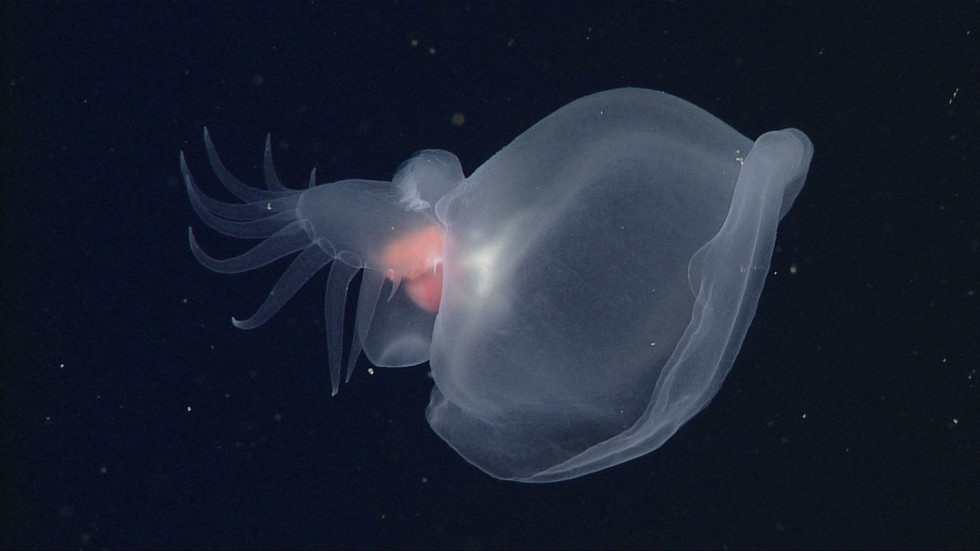A new species of sea slug, Bathydevius caudactylus, has been discovered by researchers at the Monterey Bay Aquarium Research Institute (MBARI). This glowing mollusk was found deep within the midnight zone of the ocean, a region that is typically underexplored and filled with unique creatures.
Key Findings
- Species Overview: Bathydevius caudactylus is about the size of an apple and features bioluminescence, making it glow in the dark depths of the ocean. It is considered a sea slug, but it differs significantly from other known species in both appearance and behavior.
- Published Research: The findings were officially published in Deep Sea Research Part I on Tuesday, shedding light on this mysterious creature.
- First Sightings: The species was first spotted by senior scientists Bruce Robison and Steven Haddock in February 2000 during a deep-water dive expedition off the coast of Monterey Bay. They used a remotely operated vehicle, Tiburon, to capture the initial footage of the mollusk.
- Continued Exploration: Since then, the researchers have observed over 150 sightings of Bathydevius. These observations have helped them better understand the challenges of life in the midnight zone, which lies between 1,000-4,000 meters below the ocean’s surface.
Characteristics of Bathydevius Caudactylus
- Appearance: Bathydevius has a massive bowl-shaped hood on one end and a flat tail with fringed, fingerlike projections on the other. Its internal organs are visible due to its transparent body, adding to its unique look.
- Swimming Abilities: Unlike most sea slugs that reside on the seafloor or coastal environments, Bathydevius is a swimming sea slug. Its paddle-like tail helps it navigate through the water, and it glows due to bioluminescence.
- Habitat: This species is believed to be the first sea slug to live in the deep ocean. Other sea slugs are typically found on the seafloor or in coastal habitats like tide pools.
- Name Significance: The name Bathydevius is derived from the creature’s “devious” nature, which initially fooled the scientists, while caudactylus refers to the fingerlike projections on its tail.
Research Insights
- Midnight Zone: The midnight zone accounts for nearly 70% of the world’s seawater and is located at extreme depths where little sunlight reaches. Bathydevius has adapted to thrive in this challenging environment.
- Long-Term Study: Over the past 20 years, Robison and Haddock have invested significant time and effort into studying Bathydevius and its survival in the deep ocean. Their work has contributed valuable knowledge to understanding the largest habitat on Earth.
Conclusion
The discovery of Bathydevius caudactylus adds a new piece to the puzzle of oceanic biodiversity. This mysterious sea slug offers insights into life in the extreme depths of the ocean, a largely unexplored and essential part of Earth’s ecosystem.
Multiple-Choice Questions (MCQs):
1. What is the newly discovered species of sea slug named?
a) Bathydevius caudactylus
b) Tiburon glaucus
c) Monterey mollusk
d) Sea Lanternus
Answer: a) Bathydevius caudactylus
2. Where was Bathydevius caudactylus first spotted?
a) Great Barrier Reef
b) Offshore of Monterey Bay
c) Mediterranean Sea
d) Pacific Ocean
Answer: b) Offshore of Monterey Bay
3. What is a distinguishing feature of Bathydevius caudactylus?
a) It has wings like a bird.
b) It glows with bioluminescence.
c) It has a shell like a turtle.
d) It can breathe underwater without gills.
Answer: b) It glows with bioluminescence.
4. What depth range is known as the “midnight zone”?
a) 500-1,000 meters
b) 1,000-4,000 meters
c) 4,000-7,000 meters
d) 7,000-10,000 meters
Answer: b) 1,000-4,000 meters
5. What was the main method used to study Bathydevius caudactylus?
a) Aerial surveys
b) Remotely operated vehicle
c) Submarine expeditions
d) Satellite imaging
Answer: b) Remotely operated vehicle
